Georgia is full of natural beauty that is just waiting to be discovered. This country is full of surprises – from mountains to beaches, swamps, canyons, forests and caves.
Natural objects of Georgia

There is one way to check out all the natural wonders that make Georgia’s landscapes so unique – go on a trip to this country. Call us at +995599955541 and we will add unusual places to your itinerary in this amazing country!
The karst cave of Krubera
This is the deepest known cave on Earth, hidden in the extremely remote Arabika mountain range in the Western Caucasus in Аbkhazia. Arabica is the largest karst massif on the planet. Unfortunately, this area, including the kruber cave, is extremely poorly studied due to its remoteness. And also because it is only available four months of the year. The climate here is humid – in winter a thick layer of snow forms (which can close the narrow entrance to the cave), and every spring it melts and causes flash floods.
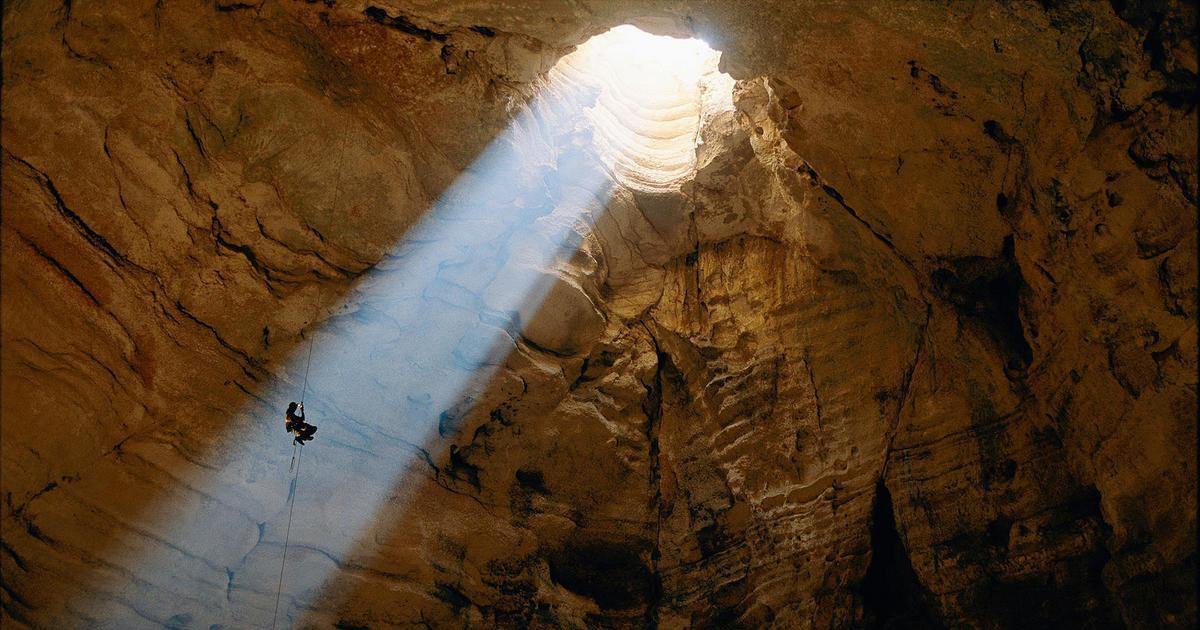
The Arabica massif was formed from a huge limestone shield. This mountain block contains several hundred caves, and five of them are deeper than a thousand meters. Most likely, these caves began more than 5 million years ago. Their formation in the Arabica massif continues to this day. The water here is very cold (which slows down karst processes), but in abundance (which facilitates karst processes).
Kruber cave was discovered by Georgian speleologists in 1960. It was named by him in honor of Alexander kruber (1871-1941) – an outstanding Russian geologist, researcher of karst processes.
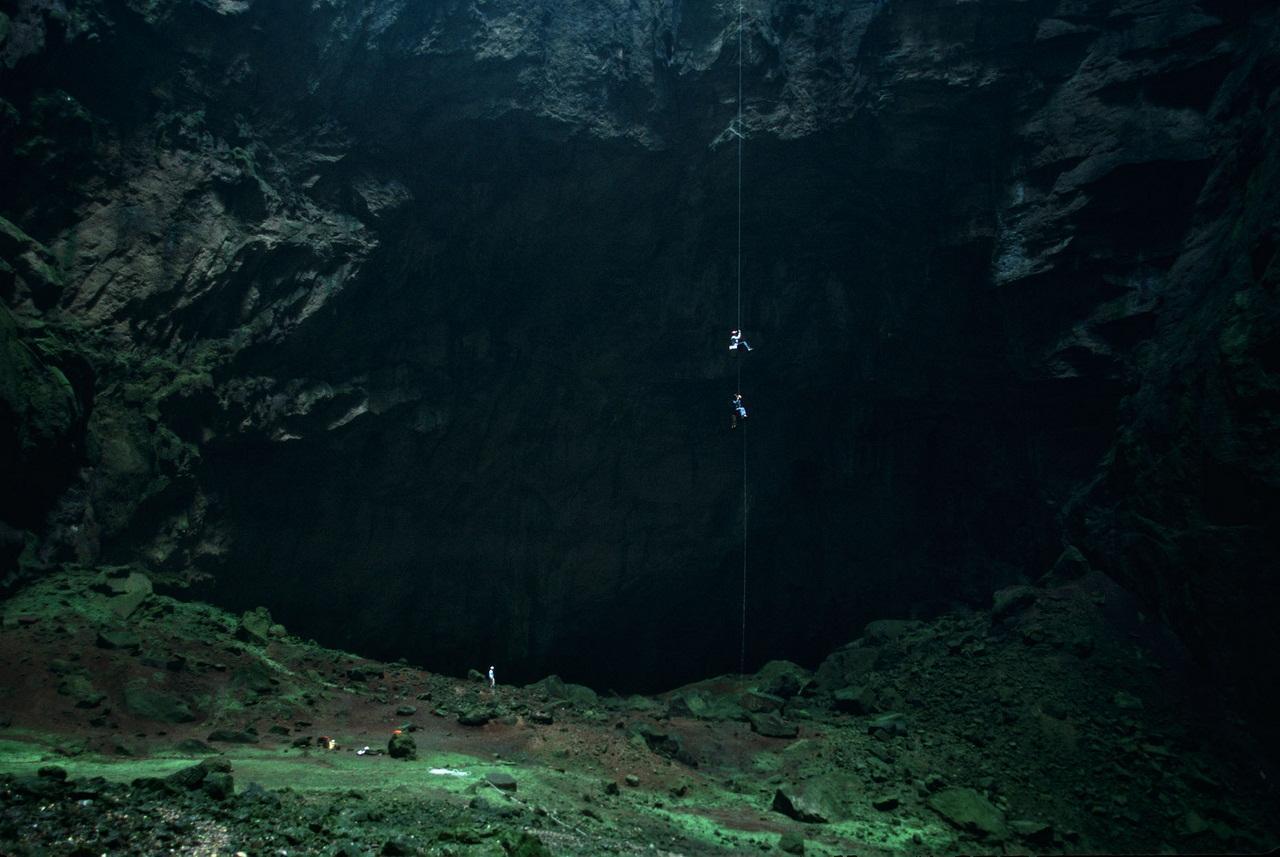
The cave is located in the Orto Balagan valley formed by a glacier. It was declared the deepest in the world in 2001. In fact, it is a system of caves with a length of 16058 m, which for the most part consists of deep vertical wells connected by passages. It begins high in the mountains, at an altitude of 2256 m. Inside, it is very narrow in places – it can be penetrated thanks to the hard work of numerous expeditions that have widened some of the passages.
In the depth of the cave there is a terminal lake “Two Captains”. The water in the cave is very cold. At a depth of 100 m, the temperature is only 1 °C, at a depth of 2000 m, it reaches 7.2 °C. The air temperature is also low. Analysis of stalagmites from the kruber cave shows that these cave formations are more than 200 thousand years old.
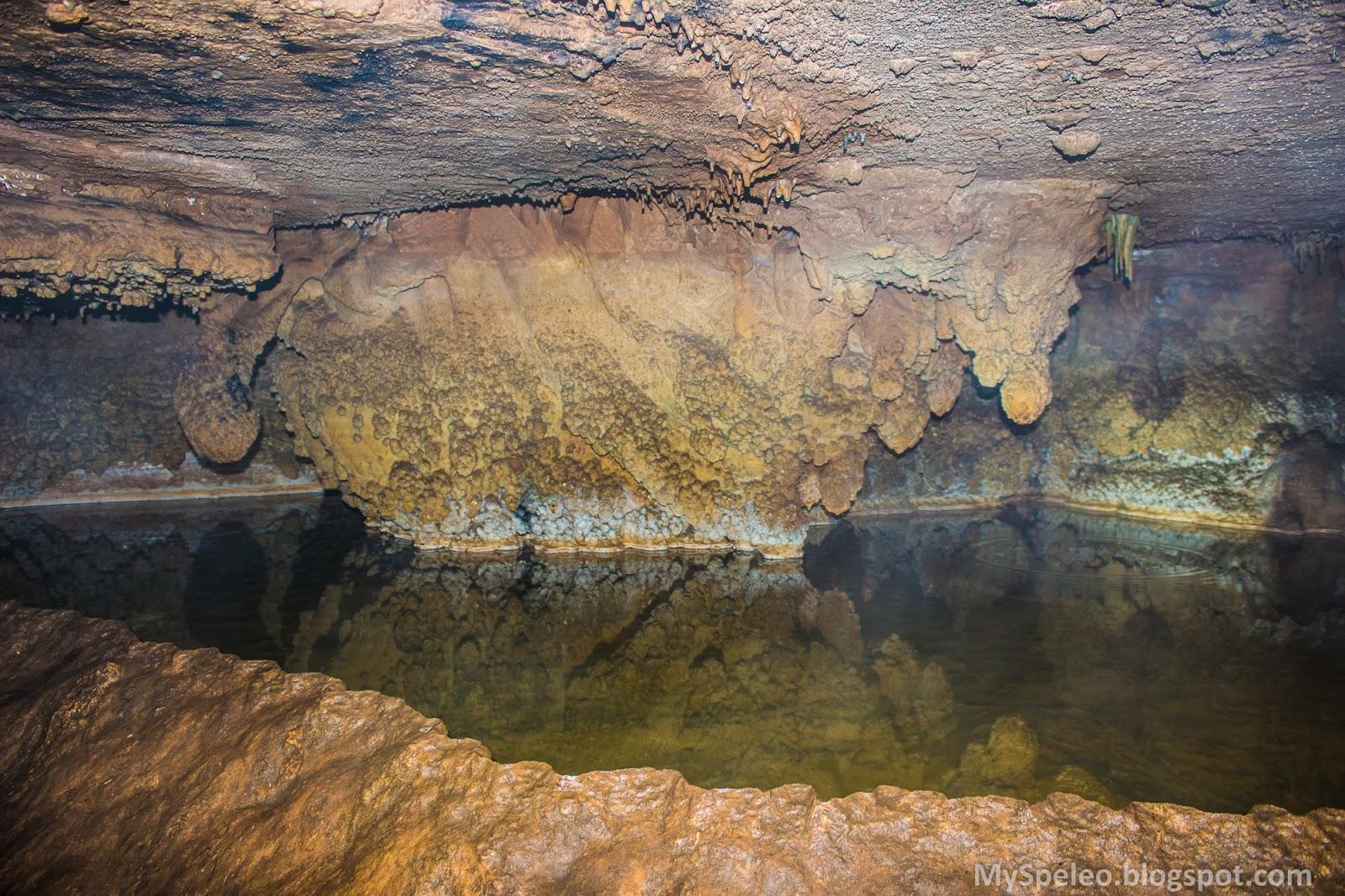
The Martvili Canyon
Мartvili is located in the Samegrelo region, Western Georgia, 50 km from Kutaisi (Imеreti).
Martvili canyon is an amazing natural phenomenon. Previously, the Georgian nobility, the family of princes Dadiani, came here to bathe. Now it is a popular tourist destination. Swimming is forbidden, but visitors can enjoy the scenery, waterfalls, steep rock slopes, and take a 300-meter boat ride on the Abasha river, which is characterized by a deep green color.
During walking or boat tours in Martvili canyon, tourists can explore the Dadianis trail, the gorge of the mountain river, natural limestone bridges, observation platforms, waterfalls, a water mill of the XIX century, fossilized shells of Nautilus and sea urchins. There are Hiking trails in the canyon (about 300-500 m), and a boat ride, including stopping time, takes about 15 – 20 minutes. Walking routes are no less impressive than a boat trip.
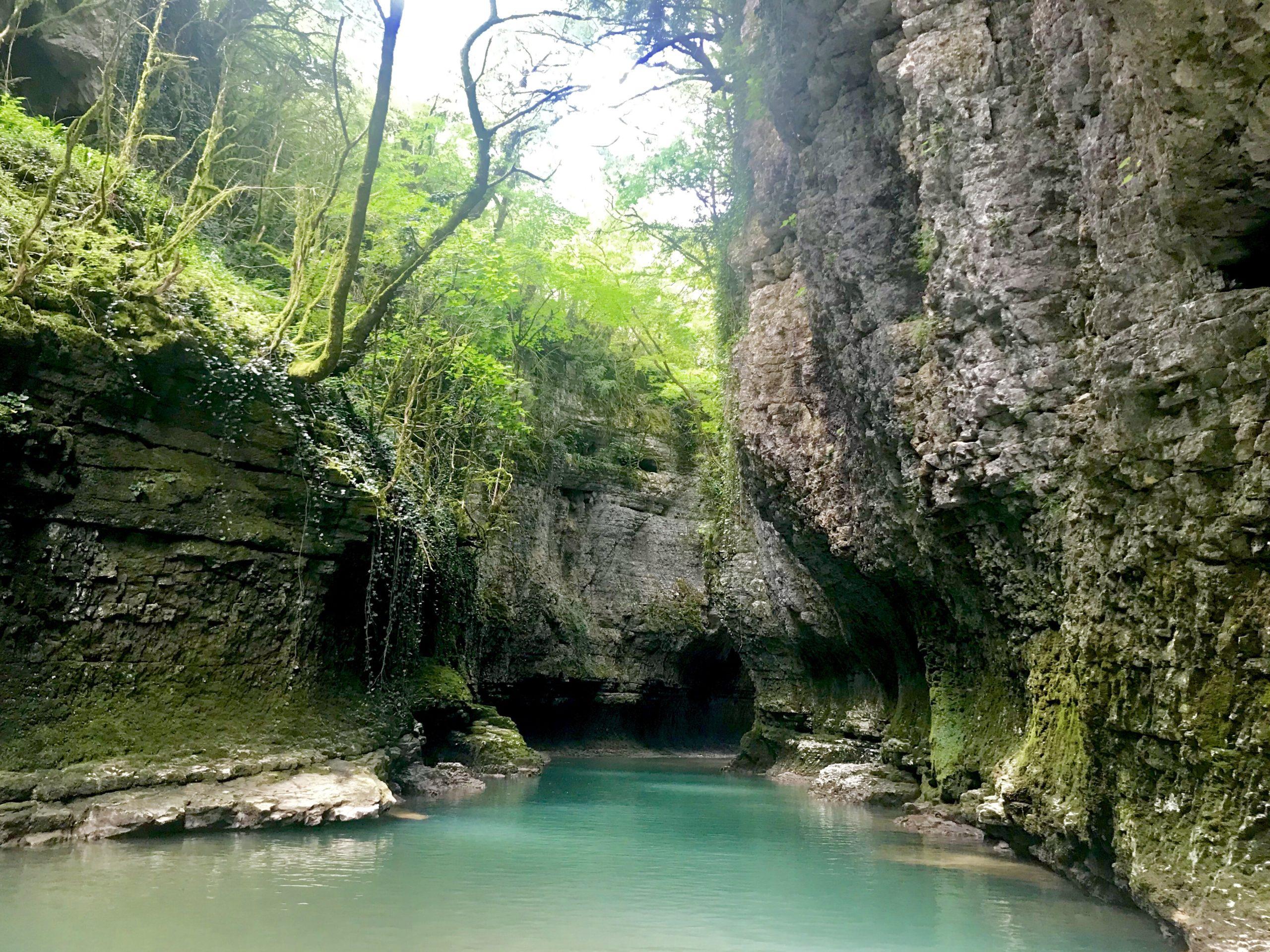
Lake Tobavarchkhili
Tobavarchhili-Silver lake, located at 2650 m above sea level. It is a serene breakaway among huge and harsh mountains. The walking route to Silver lake begins in the tiny village of MUHURI, in the mountains of the Samegrelo national Park, located in Samgrelo-Zemo Svaneti. Lake Tobavarchkhili difficult to reach, it takes several days with overnight stays in tents. However, such a journey will never be forgotten. After all, you can see many natural attractions along the way – river gorges, dense forests, beautiful Alpine valleys, snow-covered passes. Along the way you will meet two more volcanic lakes surrounded by rocks, waterfalls, canyons, caves. You may also come across shepherds, and they will treat you to homemade Georgian cheese Suluguni and local national dish elarji. This will be the magic of life outside of the civilized world, without mobile communication, without the ability to reach a locality in at least 2 days.
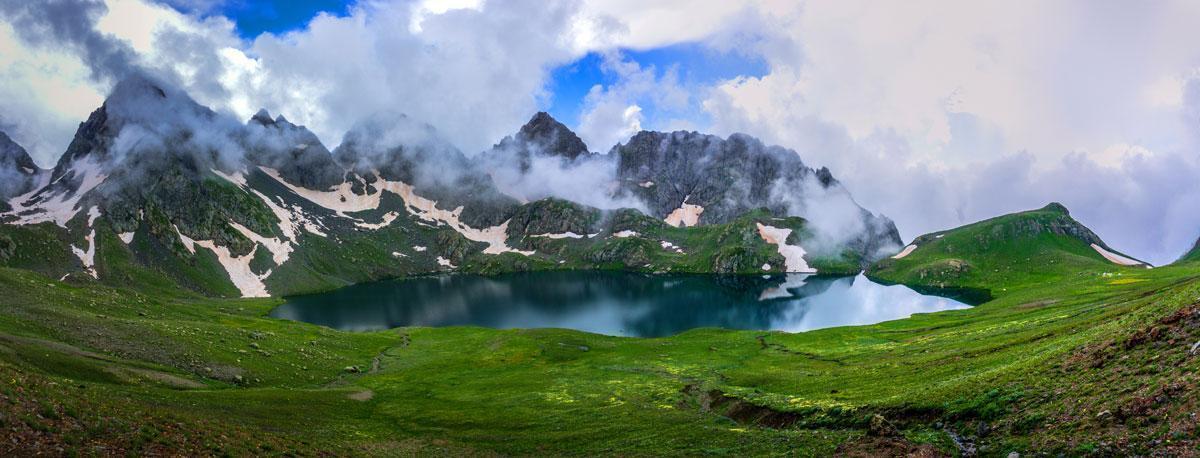
Шхарский массив
Shkhara is the highest point in Georgia. It is located in Samegrelo-Zemo Svaneti along the Russian border, 88 kilometers North of the city of Kutaisi, the second largest city in Georgia. Shkhara is the third highest peak in the Caucasus and the fourth highest in Europe after Elbrus (5643 m), Dichtau (5204 m) and Koshtana (5151 m). This is a steep peak in a heavily icy region, posing serious dangers for climbers.

Its Northern side (on the Russian side) has an altitude of 1500 meters and contains several classic complex routes. Here the ascent is most difficult. The ascent to Shkhara is easier from the Georgian side, starting from the UNESCO-protected village of Ushguli in Upper Svaneti. Due to the inaccessibility of the region, questionable security and relatively poor structures on the mountain, climbers rarely climbed from the Georgian side and almost always chose the Russian part of the mountain. There are many gorges in the Shara, so it is recommended to climb the mountain only in the summer months and in early autumn, and with a guide.
Spanish peat bogs
The famous peat bogs are located about 30 km from Batumi, in the area of the resort town of Kobuleti in Аdjara on the territory of the reserve. The Spanish marshes are included in the list of wetlands of international significance. This is the world’s most unspoilt peat bog of sphagnum (commonly known as peat moss), with an area of 770 ha and is located less than 300 m from the sea coast. The sphagnum layer is very thick-25-45 cm, the moss is soft. Together with water, peat moss creates a completely smooth dome without any bumps. The dome rises to 4 to 5 m above its surroundings.

Peatland is an inexhaustible source of oxygen and plays a major role in the carbon production cycle. At the same time, it helps regulate the regional and local climate. The swamp protects Kobuleti from flooding. Sphagnum moss absorbs water like a cloud, since it can contain much more water than its shape would indicate. In 1964, during the excavation of a drainage channel, an ancient settlement was discovered here, Dating back to the IV and III centuries BC. It is assumed that people settled in this area from 5 to 6 thousand years ago.
You can cross the swamp on a suspension bridge, admire the rare white moss decorated with yellow and white rhododendrons, listen to the croaking of frogs.
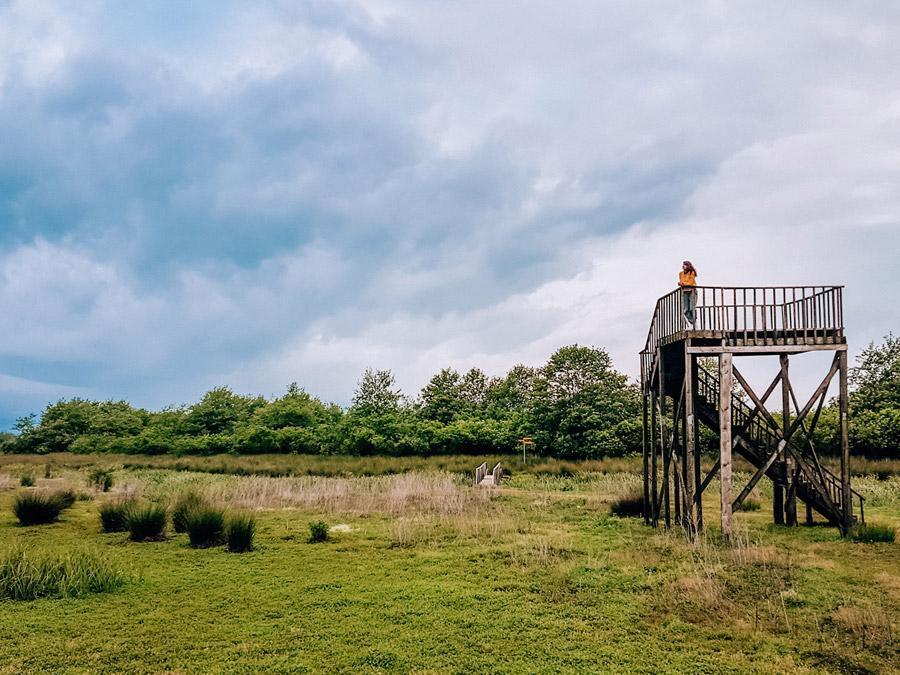
Mahuntseti Waterfall
This is a very popular place in Georgia. It is located in Аdjara,
in the village of Mahuntseti, hence the name of the waterfall. The height of the waterfall is 50 m, which is quite a lot. There are whirlpools. You can stand under the jets of falling water right in the natural bowl below, the water in it is clean and cold.. It is worth coming here in the summer, when the water level in the river Adjaristskali, which feeds the waterfall, falls, and there will be sandy beaches on the banks.
Half a kilometer from the waterfall is a medieval stone bridge built in the time of Queen Tamara. This bridge is 900 years old. In General, 25 such bridges have been preserved in Adjara, but Mahuntseti is the most popular. It is not wide – only 2.5 meters. This bridge was built from fragments of rocks, which were connected with lime mortar. Surprisingly, the bridge survived several earthquakes and survived.
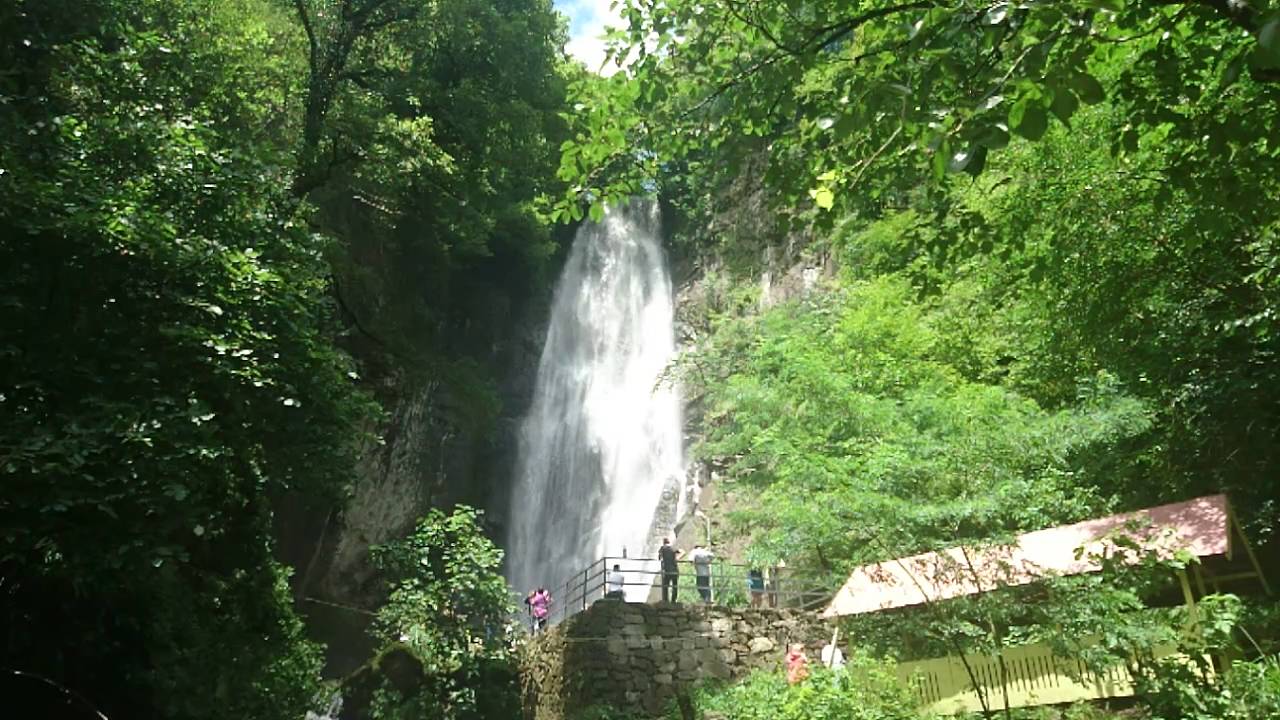
The Khvamli Mountain
Khvamli, also known as Khomli, is a huge limestone massif located in thе Racha-Lechkhumi and Kvemo-Svaneti regions,
one of the most beautiful regions of Western Georgia. The highest point of the Khvamli massif is 2002 meters above sea level. The array itself has a height of 300 meters, making an impression on the audience from below. It dominates the landscape of the region to the extent of influencing the local climate.
It is not surprising that the ancient Georgians considered Khvamli the abode of Elia, the weather God, and worshipped it. Here, according to legend, Prometheus (Greek mythological hero, Amirani in Georgian mythology) was chained and tortured. Also, according to ancient Georgian historical sources, the main treasure of the Georgian Kingdom was sent for storage in a hidden cave after the Mongols invaded Georgia in the XIII century. Among other notable features, Khvamli is also a place where many medicinal herbs grow. Some of them are unique to it and are not found anywhere else in the world.
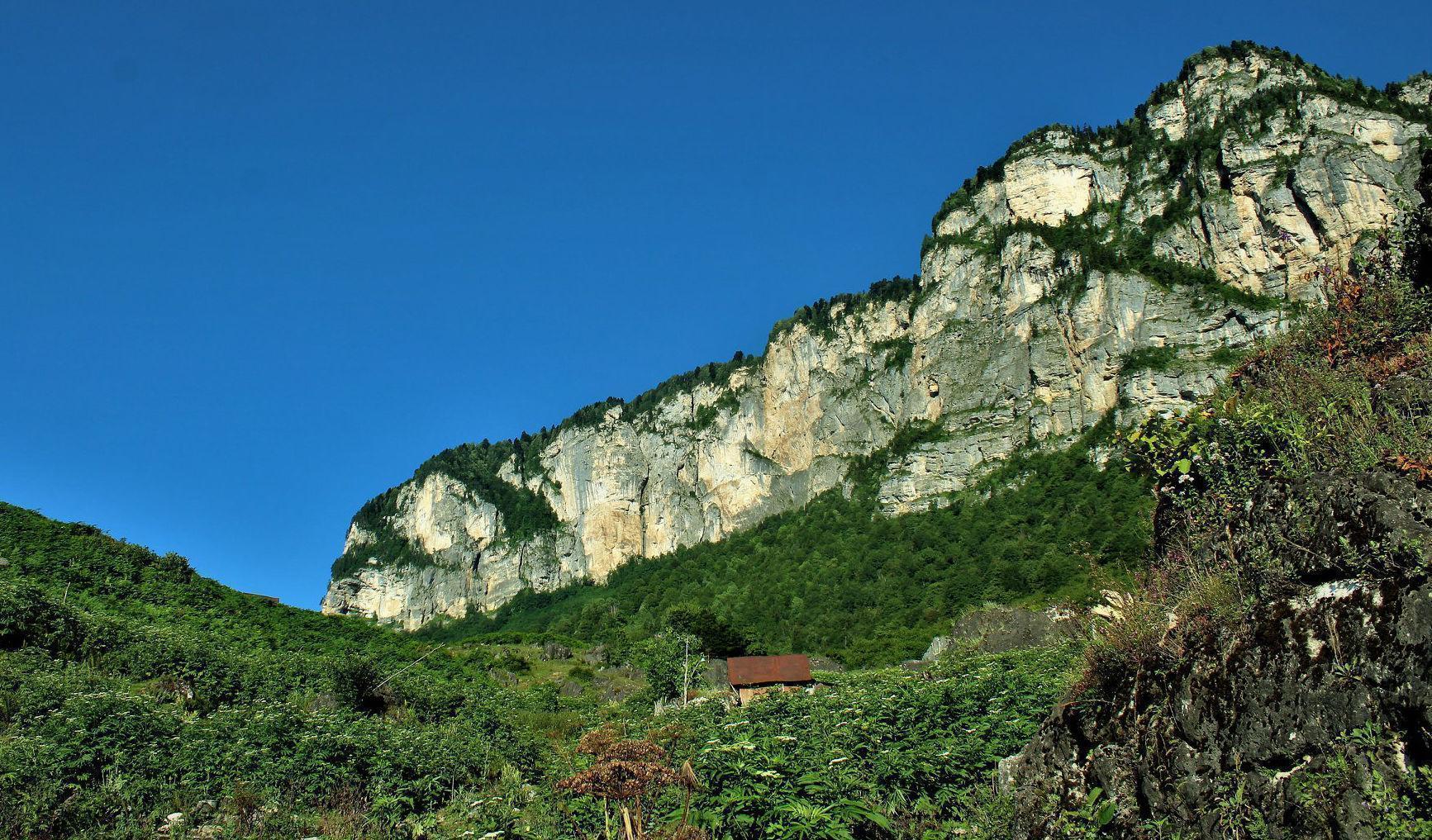
The territory of the mountain is covered with forests and Alpine valleys, moraines, snow-capped peaks and giant rocks. These rocks and mountains are habitats for many or rare species of animals and birds. A walk through the villages ends with a visit to the local wine house in the mountain village of Korinishi, where you can taste traditional Georgian wine and local homemade dishes.
Prometheus Caves
Near the city of Tskaltubo, 20 km from Kutaisi (Imereti) there are several interesting caves, each of which has its own history. The legendary Prometheus, who in Greek mythology stole fire from the gods, was chained to the mountain Khvamli. And Prometheus cave (official name of Kumistavi) is one of the most amazing places in Georgia. The length of the cave is 11 km, but only a small part of it is open to the public. Here you can watch stalactites, stalagmites, underground rivers and lakes, enjoy a beautiful 1.2-kilometer walk in a mysterious and cool atmosphere and a short boat ride. The cave offers quite a pleasant walk, lit with colored neon, the temperature inside the cave is kept at 14 degrees all the time, which is very comfortable.
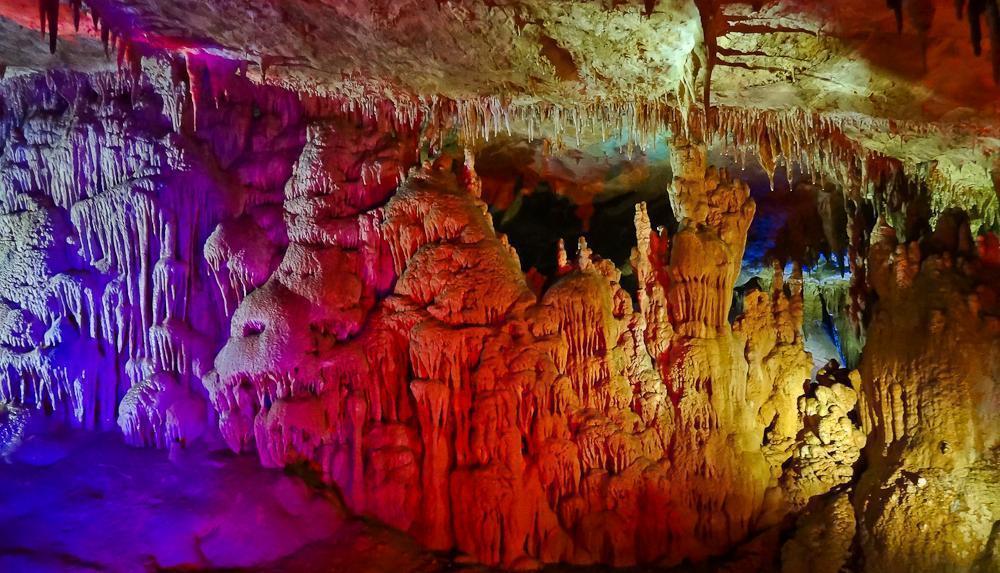
Prometheus cave is longer and more impressive than the other Sataplia cave. But when you visit Sataplia, you can see a beautiful heart-shaped stalagmite. And then walk through the forest, from above to admire Kutaisi, as well as to see the traces of ancient dinosaurs and visit a small Museum of dinosaurs.
Katskhi Pillar
It is a natural limestone monolith that rises more than 130 pounds, or 40 meters, up. At its top is probably the most isolated and most sacred Church in the world. The pillar is located about 200 kilometers West of the capital of Georgia, in the village of Haikhi (Imereti). This famous landmark is extremely difficult to access. There are no trains in this part of the region, so the only way to get there is by car or bus.

The Katskhi complex is unique. At the top of the column is a Church built in the VI – VIII centuries. Until the XV century, hermit monks lived here, but after the invasion of these lands by the Turks, the monastery fell into disrepair. It was only in 1993 that the Church on the rock was restored. It is dedicated to Maximus the Confessor, a monk who lived in the seventh century.
At the base of the column is a monastery and a small Church of Simeon Stilit and the ruins of the old wall and bell tower. Every day, the monks who live below make a 20-minute ascent up a thin metal ladder bolted to the edge of the cliff. It is believed that daily pilgrimage brings them closer to God. Today, only monks are allowed to climb this staircase. Despite the fact that tourists are forbidden to climb to the top, the magical view of the huge pillar is unique in itself.
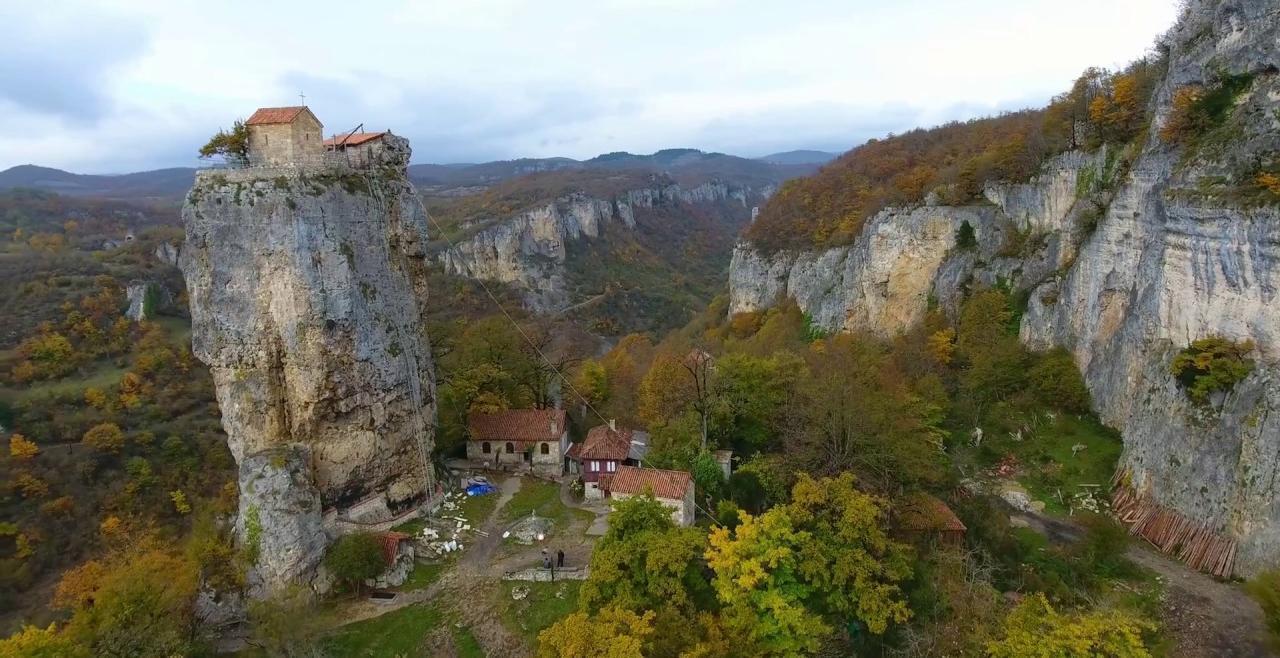
Canyons Of Birtvisi
This is one of the unique places in Georgia, located in the Кvemo-Kartli region, not far from Tbilisi. The place is cut by numerous gorges. Once there was a river that formed the canyons. There are hundreds of canyons, some more than a hundred meters high. There are those that simply rise above the wooded area. And there are also those where you can see waterfalls and natural reservoirs. This is a Paradise for mountaineers and ordinary travelers.
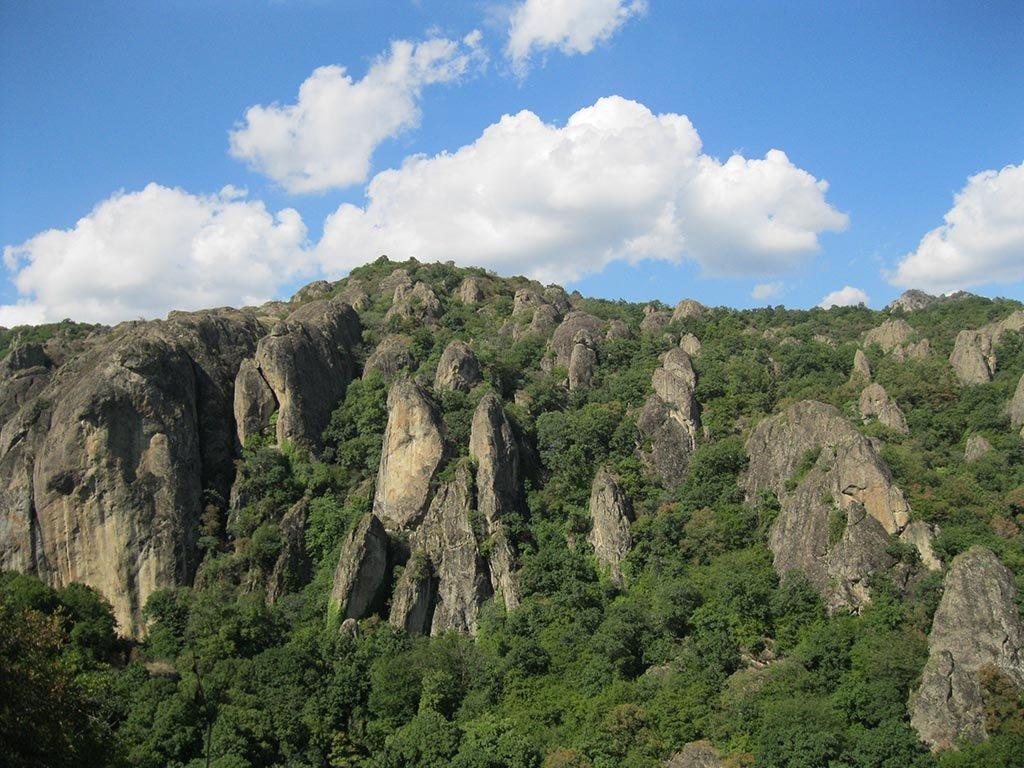
Birtvisi canyons are an unforgettable natural monument. Tourists are impressed by the quaint rocks and dark paths between them, cozy grottoes and wide panoramas from above. Once the Birtvisi canyons were a natural obstacle in the way of the Mongols. Then a fortress was built on the top, the ruins of which are still preserved. The uniqueness of the fortress lies in the fact that it is made of very large stones, improbably raised from the ground to a huge height.
Lakes Of Abudelauri
Abudelauri color lakes are located in the picturesque surroundings of Mtskheta-Mianeti region–
this is one of the most beautiful and important parts of mountainous Georgia, whose natural and cultural resources are almost inexhaustible.
Colored lakes of Abudelauri are really a miracle of nature, they have different shades: bright green, blue and white. According to the legend, and sugar was angry at the evil Deva who was hiding at the bottom of lake Abudelauri. He threw himself into the water after it and delivered the fatal blow. But the blood of the diva covered the surface of the lake, and Sugar could not get out of it until the inhabitants of the nearest village lowered the blood of a sheep into the lake. And then the water opened, released the sugar, which turned into a dove, and turned to an emerald color.
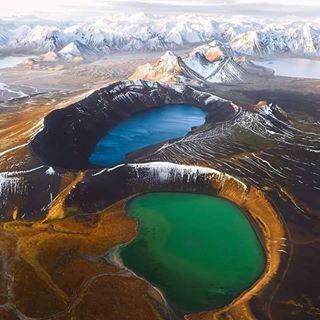
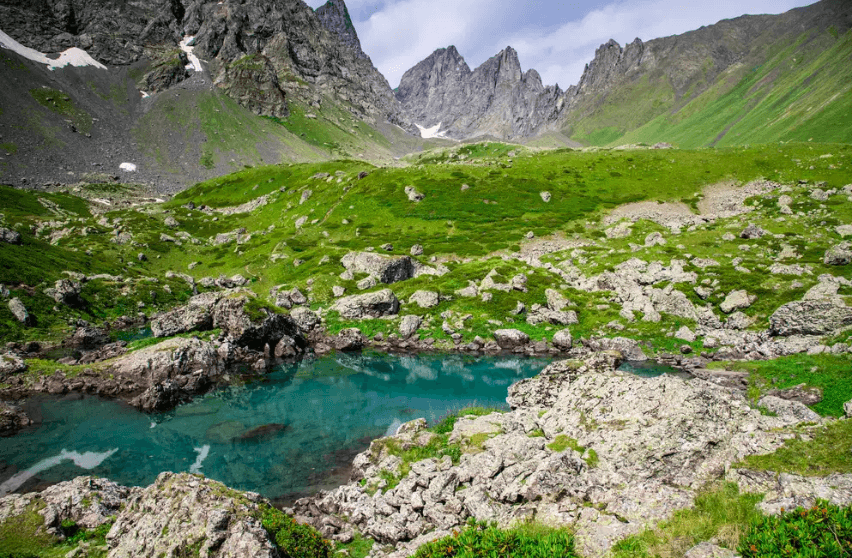
Lakes are on the list of the rarest creations of nature. They are of glacial origin and feed on snow and glacier meltwater and rainwater. The maximum water level in the lakes is recorded in summer, and the minimum in winter. For a long time (more than 6 months), the lakes are covered with ice, from which they are released only in may. White lake and blue lake are not far from each other. All three lakes merge perfectly with authentic nature, which makes the Khevsureti region even more impressive.
The Gorge Of Truso
The trusso gorge and valley are located on the Northern slope of the Caucasus towards Russia, along the Terek river in the Mtskheta-Mianeti region. The length of the gorge is 25 km. The journey to it will take 4-6 hours depending on how far you go up the valley. This is a difficult path through inaccessible and sparsely populated places. Once there were 12 villages in the gorge, but today they are abandoned. There are almost no people there.
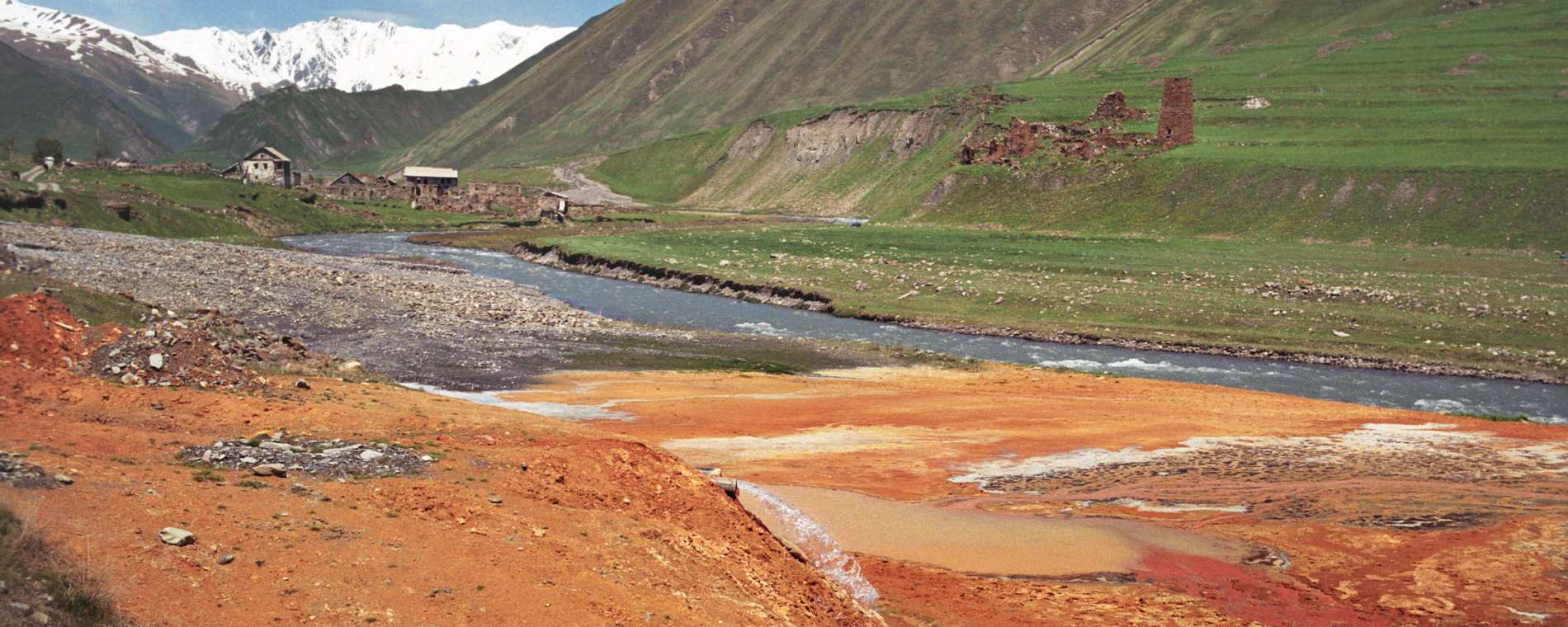
But you will be rewarded with a wonderful nature, many mineral springs. It is no accident that this place is called the valley of narzans. The gorge is rich in hydro-carbonate mineral waters, and traces of them can be seen everywhere. These are travertines-calcareous deposits of mineral water. The stormy Terek is ready to knock down the force of its current, and the “narzannoe” lake with natural gas bubbles looks bottomless.
Previously, each of the villages had its own tower, or even several. Today, the preserved tower of the XVII century is only in the village of Abano, where there is also a functioning convent.
We know all about the unique natural attractions of Georgia. Call: +995599955541, and our consultants will offer you the best route to different regions of the country.

 geogeorgia.travel@gmail.com
geogeorgia.travel@gmail.com




